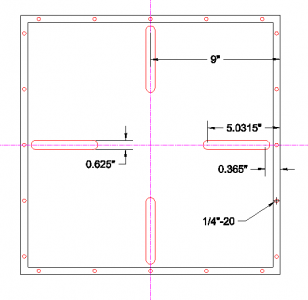- Joined
- Mar 14, 2014
- Messages
- 74
Hey all. I just joined the forum because I'm about to dive headfirst into a project that's waaaaay more involved than than anything I've ever tried before and I know I'll have questions. I'm pretty mechanically inclined (even though I'm trained as a chemist) and my boss knows this so he goes and asks me to build whats basically a bench mounted robot with stepper controlled leadscrews and pneumatics (all automated). Anyway, I have a solid design mostly worked out and soon it will be time to build it. Only thing is that we don't have an in-house machine shop so we need to get at least a mill on top of the raw materials. I'm putting together a requisition to order a mill and for a while I'd been dead set on getting the solid column Little machine shop mill with the tooling package but the more I thought about it, the more I think it might be slightly undersized for what to do. I was looking around for similarly priced machines that I could put on the req as comparison quotes and stumbled on the G0704. Its about the same cost shipped and has no tooling but a larger table
Enough background, here's what I need to do: The core of this machine will be an 18"x18"x1/2" aluminum base-plate to which everything will be attached. In addition to the 1/4"-20 holes around the edge, I need to mill four 5/8" slots in a cruciform pattern around the center.This certainly seems like it would be pushing the little machine pretty hard but i think it should be doable. The center of the ends of the slots are 5" from the edge and according to LMS, the throat on the 3960 is 6.5". I'd probably need to drill some extra 7/16" holes so that I can use the clamping kit to bolt the plate to the table but it should be possible, at least dimensionally, to make the part. The maintenance department has a pretty beefy drill press so the peripheral holes and any clamping holes should be able to be made relatively easily on that. My main problem is the slots. According to Wolfram Alpha, the base will weigh just under 16 pounds which I imagine is a good bit less than the vice that will be mounted on the table most of the time. My main concern is the torque since about half of the plate will be cantilevered off the edge of the table which might put some unpleasant twisting stress on the gibs and ways.
Unless I get a strongly negative response from the HM brain trust, I'm still leaning towards the LMS mill for a few reasons. First, the next largest part I need to make is less than a third the size of the base and the rest of the smaller parts are smaller still. These smaller parts will demand precision that I'm not confident the grizzly machine has. Second, the lab space where this mill will go isn't that big so that the smaller footprint of the 3960 would be helpful. Not to mention the quieter operation in the lab and generally higher quality of the LMS option. Third is obviously cost. Having the machine and most of the needed tooling together (and as one line item) for under $1500 will make the approval process much faster and easier and I'm eager to get started on the project.
Edited to fix an error in the picture

Enough background, here's what I need to do: The core of this machine will be an 18"x18"x1/2" aluminum base-plate to which everything will be attached. In addition to the 1/4"-20 holes around the edge, I need to mill four 5/8" slots in a cruciform pattern around the center.This certainly seems like it would be pushing the little machine pretty hard but i think it should be doable. The center of the ends of the slots are 5" from the edge and according to LMS, the throat on the 3960 is 6.5". I'd probably need to drill some extra 7/16" holes so that I can use the clamping kit to bolt the plate to the table but it should be possible, at least dimensionally, to make the part. The maintenance department has a pretty beefy drill press so the peripheral holes and any clamping holes should be able to be made relatively easily on that. My main problem is the slots. According to Wolfram Alpha, the base will weigh just under 16 pounds which I imagine is a good bit less than the vice that will be mounted on the table most of the time. My main concern is the torque since about half of the plate will be cantilevered off the edge of the table which might put some unpleasant twisting stress on the gibs and ways.
Unless I get a strongly negative response from the HM brain trust, I'm still leaning towards the LMS mill for a few reasons. First, the next largest part I need to make is less than a third the size of the base and the rest of the smaller parts are smaller still. These smaller parts will demand precision that I'm not confident the grizzly machine has. Second, the lab space where this mill will go isn't that big so that the smaller footprint of the 3960 would be helpful. Not to mention the quieter operation in the lab and generally higher quality of the LMS option. Third is obviously cost. Having the machine and most of the needed tooling together (and as one line item) for under $1500 will make the approval process much faster and easier and I'm eager to get started on the project.
Edited to fix an error in the picture

Last edited:

